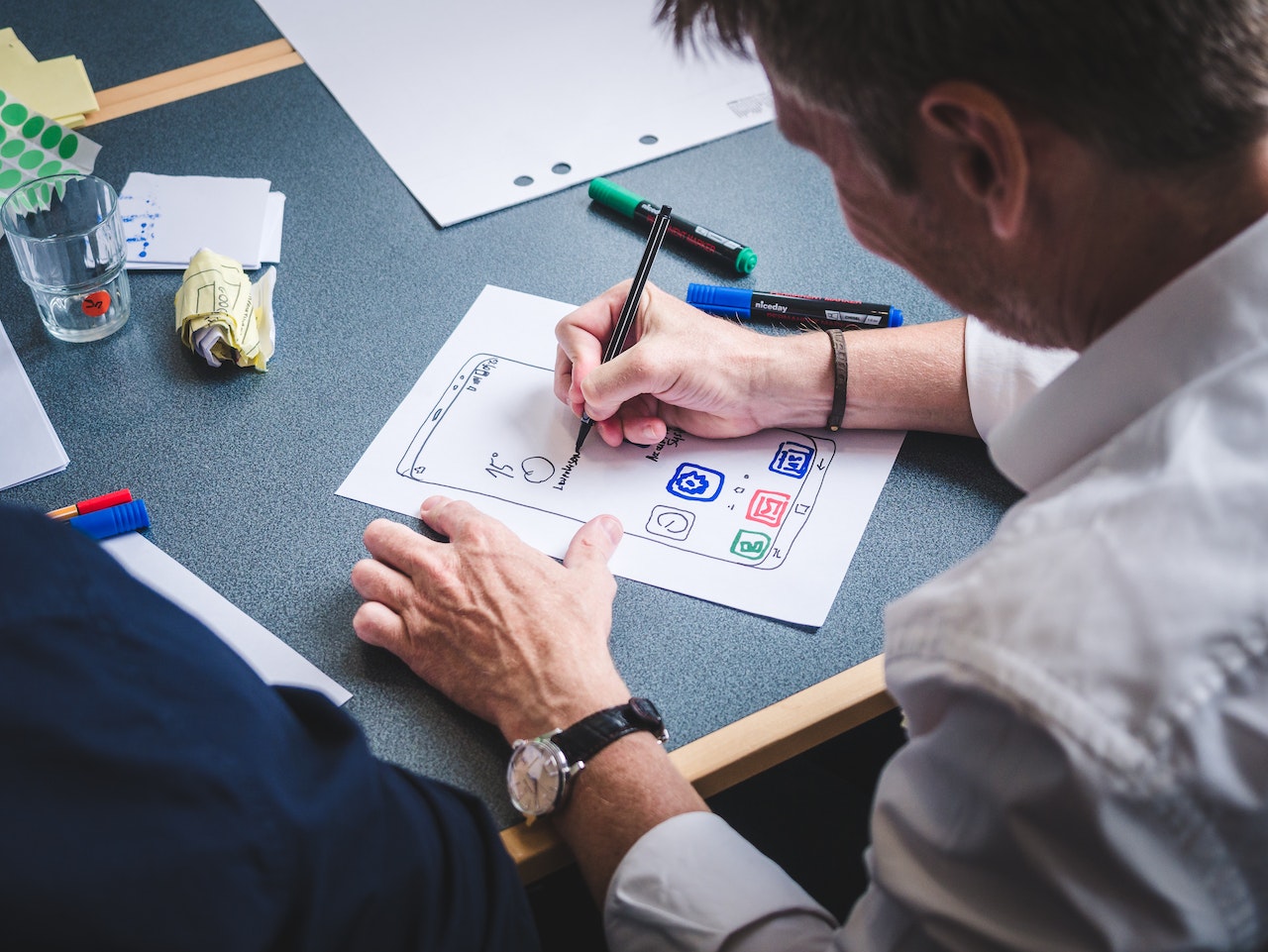Agile & Design Thinking
Imagine a world where projects fall within budget, hit all the milestones on the timeline and products get delivered perfectly to the user needs.
Sounds too good to be true?
That is what design thinking and agile sets out to do. In the 2020 edition of Pulse of the Profession® 59% of organisations surveyed reported using design thinking to explore and solve problems. Yet striking the right balance of creativity and innovation requires deliberate focus to unlearn what we understand of project management and relearn how to do proper product development.
Challenges of a traditional product development approach
Before agile, let’s take a look at the drawbacks of the traditional product development approach:
- Sequential and gate-oriented process – This step by step approach means tasks can’t move unless the previous step is cleared
- Handover between people – There will be some knowledge loss as information is passed from researchers to product developers
- Risk of solving a wrong problem or developing the wrong product – Sometimes it can be a case of developing the right product but solving the wrong issue
- Long timeline with tunnel effect, in the sense that product development can drag on without the end in sight
- Generates a lot of waste
In short, this approach may not create the expected value for users and the company.
How to deliver a valuable product? Ask the user.
Adopting a user-centric approach is something we hear quite often when designing any sort of user experience. But what exactly does it mean?
Put simply, it’s keeping the user in mind at every step of the design process, not just at the beginning or near the end when the product is about to launch.
Tim Brown, the President and CEO of global innovation and design company IDEO, defines design thinking as “a human-centred approach to innovation that draws from the designer’s toolkit to integrate the needs of people, the possibilities of technology, and the requirements for business success.”
An example to show the importance of listening to the user is the Hippo Water Roller Project in South Africa, where engineers were thinking of helping women fetch water from a faraway well more easily.
As it turns out, the women were actually unperturbed by the 1 to 2 hours’ walk to reach the well as it allowed them time to socialise and served as a needed respite from their daily routine.
Design Thinking mindset
A design thinking mindset can be broken down into these few elements.
Curiosity – Seeing things from different perspectives.
Empathy – Put yourself in the shoes of your end user. Would this solution still work?
Collaboration – This happens not just within the product team but also with external stakeholders and users.
Logic – Contrary to the belief of creativity as an unbridled force, harnessing creativity can be structured with the right process and tools.
Intuition – Rather than trying to rationalise our thoughts, sometimes we need to follow our intuition when it comes to assessing a user’s need.
Humility – Don’t assume that you know everything about the client or market you’re serving. Keep an open mind and you may discover new things during your research.
Imagination – 20 years ago, no one could have envisioned that the smartphone would be such an integral part of our lives. Yet today, businesses are tapping into VR and AR technologies to reach consumers.
Reframing – The opportunity to miss a problem or create the wrong solution is high. So constant reframing of the problem-solution you’re working on ensures you’re going in the right direction.
The 4D Framework
The design thinking process is broken down into four phases – Discover, Define, Develop and Deliver.
As the product team, you want to understand and discover the user’s pain points, your market and competitors. This is the part where team members diverge and to research and collect as much data as possible.
After collecting sufficient data, your team then converges to decide which problem to solve. There are many problems which may be worth solving, but you want to prioritise them and start with the one that will create the most value for the user and for your business.
Once you’ve defined the problem, it’s time to diverge again to brainstorm and come up with solutions. At this point, the focus is quantity and possibilities, by generating as many ideas as possible.
When that is done, the team then gathers to review a few solutions that are the most relevant to the user, prototype and test, before developing it further into a specific solution. The last stage would be where the final product is ready to deliver to the market.
Design Thinking benefits
Without defining and researching your users, it is hard to understand their needs and pain points. This helps you to define the right problem to solve.
In instances where the team jumps right into developing a product or solution, they may think that they are solving the right problem, when instead, they should back up to the “discovery” phase to gauge if there is sufficient demand for the solution.
When it comes to creating innovative solutions, it helps to define the product’s unique value proposition before quickly evaluating solutions with prototyping and testing. This helps to accelerate learnings and solutioning.
The last and perhaps most important benefit of design thinking is the ability to engage your users and co-develop the product with them.
Not only will users feel their concerns are being heard, you will waste less time and resources developing a product, only to realise you’ve been tackling the wrong problem.
Design Thinking gaps
Depending on the product team, there may be cases of creating unrealistic solutions that look nice on paper or prototype, but are too expensive to develop into actual products.
Design thinking usually ends at the prototyping phase so you may or may not have a final product in the end.
There are also some who may approach design thinking as a one-off workshop or at the initial phase of product development and not see it through the entire user journey.
In short, there are a lot of benefits you could be missing out on if design thinking is not structured into the development phase.
What does Agile bring?
The Agile mindset embraces values and principles of iteration, collaboration, and change.
You may have heard of the phrase “fail early, fail fast”.
In an environment where all team members have an agile mindset, the team can respond quickly to changing market needs, setbacks are viewed as learning opportunities, and everyone takes the chance to add to the knowledge base.
Let’s take a look at the Agile manifesto, which outlines four values and 12 principles.
The four values are:
- Individuals and Interactions over Processes and Tools
- Working Software over Comprehensive Documentation
- Customer Collaboration over Contract Negotiation
- Responding to Change over Following a Plan
In summary, the 12 Agile principles are:
Customer focus – Putting the customer at the centre of the development and along the process, to check with them if it still makes sense.
Embrace change – To plan ahead but also be able to welcome change and not be frustrated when things don’t proceed smoothly.
Deliver frequently – Avoid the tendency to develop too many features before delivering, as you may lose opportunities and time to gain traction. Instead focus on developing working software to gather feedback quickly.
Collaborate often – Getting new perspectives can make a problem interesting rather than troublesome.
Motivate and empower – A product development usually takes time and you want to motivate your peers to stay on track to deliver frequently.
Face-to-face preferred – In-person communication is more powerful than online interactions. If your team is virtual, switch on your camera.
Working product – A measurement that the team is on the right track in delivering functional software to the customer.
Sustainable pace – The team is able to establish a sustainable pace to deliver working software and repeat the process with each new release.
Excellence in design – This applies not just to the UX/UI design but also to IT architecture and internal processes.
Simplicity – Do not overengineer. Break up the development into manageable chunks so the team can develop just enough to get the job done for now.
Self-organisation – Skilled and motivated team members who have decision-making power take ownership more easily, regular communication with other team members increase product quality delivery.
Reflect and adapt – Set aside time for regular self-improvement and process improvement help team members to work more efficiently.
Scrum is one of the agile methodologies used for software development. For digital product developments, scrum is a very powerful tool that brings together different product stakeholders.
Firstly, there’s the Product Owner, who handles the Product Backlog of features to be developed.
Then there’s your team of Developers, who handles the Sprint Backlog development and build iteratively, new Product increments.
Lastly the Scrum Master is the guardian of the Scrum process supporting the team and removing impediments.
The Sprint Planning helps to define the work to be done in a Sprint and the Team organized itself to deliver it.
There is a Daily Scrum meeting to discuss in 15 minutes what has been done and where issues or roadblocks are.
At the end of 1 to 4 weeks Sprint, the team will present to all stakeholders what has been developed in the Sprint Review, followed by a Sprint Retrospective on what can be done to adapt and plan for improvement for the next Sprint.
Agile benefits
There are several benefits to the agile method:
- One of the key benefits of agile is to be able to deliver early and often.
- Rather than following a fixed plan only to realise it’s not the right plan, you’ll be building a product incrementally, whereby making small, measurable investments are made to reach a level of satisfaction at each Sprint.
- The development team is empowered with the autonomy to be self-organised about how they want to go about building the Product.
- It allows the team to focus on business value, as this would be the guiding principle for prioritising the list of features and to develop those with the most value.
- Being able to deliver often forces the team to increase product quality
- Give opportunities for improvements
- Reduce waste, as you’re prioritising tasks more accurately
- There is room to pivot based on user experience and customer feedback
Agile gaps
As with every method, there are some drawbacks:
- The team might develop the right product for a wrong problem, if the product owner does not have the right understanding or vision
- There may be over-reliance on the product owner’s understanding and vision.
- As the main feedback at the sprint review is from the product owner, it may not reflect what the end users think.
Combining Design Thinking and Agile for end-to-end customer centric product development
Design Thinking with Agile creates a complementary combination.
Design thinking fills Agile gaps in a few ways. By defining the right problem to solve, this helps the team build a collective and holistic understanding.
At the same time, users are involved throughout the entire process, from design to testing.
On the other side, Agile fills in the Design Thinking gaps. By structuring the product development process, the team can focus on fine-tuning while delivering a final product incrementally.
The Agile method also helps to enforce continuous improvement through the team and its processes.
The simple and pragmatic approach of Design Thinking and Agile
- Start the design thinking process with stakeholder mapping, interviews, observations and market research to identify competitors and opportunities
- Define the point of view through a problem statement, identifying personas and creating an empathy map
- Ideate on a value proposition canvas, a customer journey and value complexity matrix to prioritise
- Prototype and test with a story board, wire frames and digital prototype. it is important to keep testing until the team is satisfied with the outcomes
- Build purposefully with a product backlog and story mapping
- Deliver incrementally
While all the best product development methods (design thinking, lean, agile, growth hacking) can co-exist well together on paper, the fact is that it takes time for a team to master these methods effectively and definitely not in the course of one product development.
A good start is to use Design Thinking to work on the problem and Agile (Scrum) to work on the solution.
From understanding the user’s pain points to forming a point of view and ideating, the team can then work on a prototype to fine-tune the problem, before using Agile to run sprints on actual development and collect feedback.
Challenges & solutions of Design Thinking and Agile
Even with this tried-and-tested method, there are challenges and solutions.
There is the issue of continuity of the product team from design thinking to agile, whereby the designer could be involved only at the design thinking stage and the product manager only at the agile stage.
Same for technology where the tech or development lead could be involved only in the build stage where it is too late to identify technical difficulties of the solutions.
This can be resolved by having a cross-functional team that is present throughout the product development from design thinking to the agile development.
This way the team can build their knowledge of the problem and contribute to the solution from their own individual expertise.
Having a continuous loop between design thinking and agile also helps the team to get more efficient with each iteration of the development cycle.
With a trained and motivated cross-functional team you will limit the dependency on other departments who may not have a complete understanding of the product.
As you may understand now, combining design thinking with agile requires skill and active participation from all the product’s stakeholders. It requires all to be onboard with the best practices and align with the desired outcomes.
Most importantly, it requires a holistic understanding and respect for the role that each product team member plays for it to be successful.
Have a question?
The most successful agile transformations cannot be done without the expertise of an experienced agile coach and the backing of a powerful agile consultancy. If you are serious about undergoing agile transformation, we at Wavestone are happy to chat about the problems you face and how we can help.







